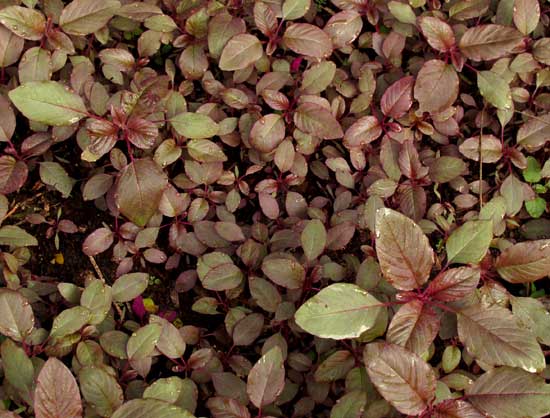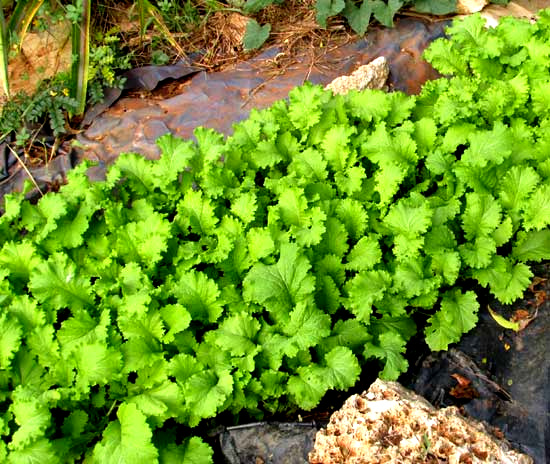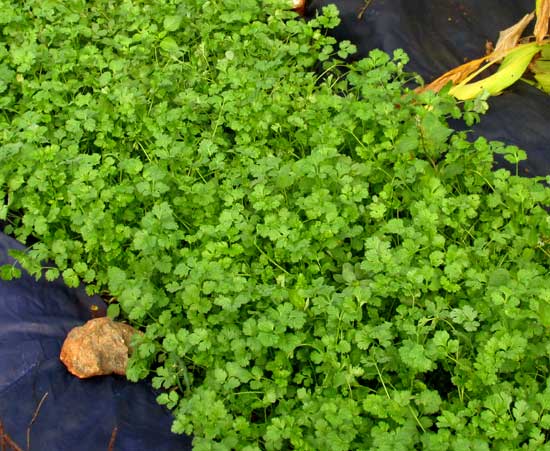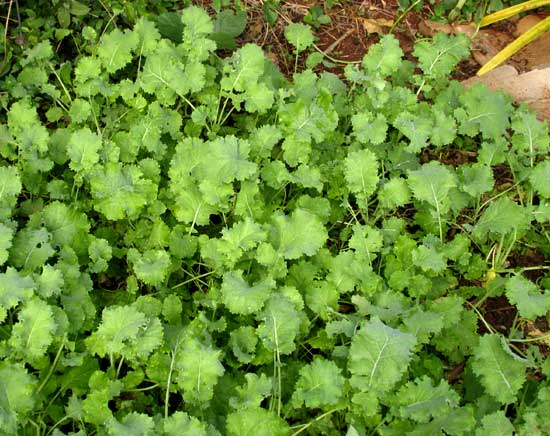Excerpts from Jim Conrad's
Naturalist Newsletter
from the January 28, 2018 Newsletter issued from Rancho Regenesis in the woods ±4kms west of Ek Balam Ruins; elevation ~40m (~130 ft), N20.876°, W88.170°; north-central Yucatán, MÉXICO
LIVING MULCH IN THE GARDEN
As we sink deeper into the plant- and animal-stressing dry season, this year's garden is much more productive than last year's, because last year I learned a lot from my failures. Most importantly, I realized that in our thin, clayey soil with its cattle-hoof-formed hardpan, before planting anything at all I needed to break up the soil with a pickax and add plenty of compost and manure. The other trick I've realized is that live-mulching makes sense.
Live-mulching is the process of growing plants so close together that the plants themselves form a protective cover over the soil, keeping out the sunlight and wind, and holding moist, relatively cooler air beneath the leaves. When visitors enter my present garden, the most spectacular case of live-mulching is provided by the Climbing Spinach we've profiled at www.backyardnature.net/mexnat/basella.htm
The garden's live-mulching Climbing Spinach is shown below:

Our Amaranth page is at www.backyardnature.net/mexnat/amaranth.htm
A live-mulching bed of Amaranth with small plants in a good stage for providing greens and a colorful addition to salads is shown below:

The live-mulching bed of mustard greens with the sweetest, most succulent leaves you can imagine is shown below:

Our Cilantro page is at www.backyardnature.net/mexnat/cilantro.htm
The live-mulching bed of Cilantro is seen below:

And who would have thought that Dwarf Siberian Kale could possibly survive here, but below you can see an excellent crop of live-mulching plants grown in the shade:

I would have had such beds of leaf lettuce and beets, but dogs and Muscovy Ducks destroyed my plantings before I realized what was going on.
Part of my live-mulching strategy is to pick and eat young, too-crowded sprouts. As the live mulch grows, the larger plants end up farther and farther apart, because I've eaten the plants between them. The soil, however, stays protected from the sun and wind, and the air below the leaves stays moist.
I'm unsure if even live-mulching will sustain the garden through the end of the dry season, for December and January are our "cold season." March, April and May are our hottest, driest time of the year. At this time, my advice for gardeners here is to plant live-mulching crops in December and January, then see what happens as the heat comes on. Whatever happens then, so far this year, live-mulching has provided wondrous results.
On the Internet, live mulching seems to be understood as planting thickly-growing plants between regular crops. So far I've not found anyone using the concept as I do, in gardens being irrigated during long, extremely hot and dry dry seasons. A good page with a general look at live mulching in organic gardens is at http://www.organicgardeningtips.info/organic-and-living-mulches/